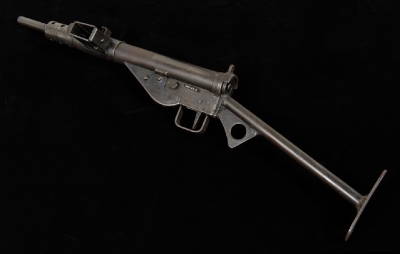Sten (1997.43.2)
After the Battle of Britain (1940), Britain was hard pressed for arms, money, and raw materials. The authorities wanted a cheap sub-machine gun to combat those used by Germany (sub-machine guns are carbines which fire pistol cartridges at the rate of a machine gun). The result was the Sten, its name combining the initials of the designers Shephard and Turpin plus the first two letters of ‘Enfield’, the Royal Small Arms Factory at Enfield where it was produced.
The Sten (this is the MkII 9mm version) was a basic gun, which took a few hours to make and cost less than a good pair of shoes. However, it put automatic fire into the hands of inexperienced troops and versions were traded to, and copied by, China, Germany, Palestine, Argentina and Indonesia. The Sten’s major disadvantages were jamming due to the poorly designed magazine and accidental discharge. British troops disliked it so much they nicknamed it the ‘Plumber’s Delight’ or the ‘Stench Gun’.





